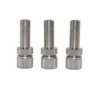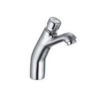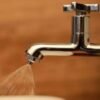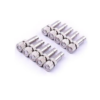Outer Shell – SS316
Insert – Brass
nozzle orifice – 0.1 to 2.0 mm
operating pressure – up to 10 bar for push fit connectors
up to 80 bar for threaded connection
other connection size available – 3/8″ & 1/2″ BSPT thread
best suitable for automatic hand sanitizer machine, disinfectant tunnels, dust suppression, outdoor cooling, sanitization devices and other spraying applications
available with anti-drip function too
The size of the water droplets that make up the mist helps determine how much cooling effect you’ll be able to feel. As each little droplet evaporates, it cools the air immediately around it. Bigger droplets take longer to evaporate than smaller droplets. If they land on you before they’ve completely evaporated, you’re wet. If you’re in fairly dry air this can feel great as the water evaporates off of your skin. On the other hand, it can be uncomfortable in extremely humid weather, or if you just don’t want to be wet. Also any water that doesn’t evaporate must land on something. You’ll need to make sure it doesn’t puddle and that what it lands on is water-safe.
Smaller droplets evaporate mid-air. This is sometimes called “flash evaporation” because it happens “quick as a flash” and gives a stronger cooling effect. Also, smaller droplet can spread or “drift” more than larger droplets, cooling a larger area.
The lower pressure misting systems that yield larger water droplets also yield fewer water droplets. Fewer, larger water droplets around you cool the air unevenly. You can sometimes feel little spots of cool air surrounded by the unaffected hot air. It can feel like standing by a waterfall. The higher pressure misting systems that yield smaller droplets also yield more water droplets. The air is cooled more evenly and feels more like a fog. You are less likely to feel the warm air and more likely to simply feel the cooled air with these. Same amount of water, different number of droplets. Different cooling effects.
Orifice Diameter range starts from 0.4 mm to 2.00 mm.
Misting nozzles are designed to create a spray that angles out anywhere from 40° – 100°, depending on your system’s water pressure. The wider the angle, the more area the spray will cover and the fewer nozzles will be needed. 18, 24 or 30 inch nozzle spacing is standard, but some suppliers will customize spacing to your needs. Nozzle spacing in plastic, nylon, and copper lines can be easily customized during installation, too.
How far in the air the spray “drifts” or spreads is determined by their height off the ground, the system’s water pressure and the size of the nozzle, plus the temperature of the water and the outside air.
For maximum cooling effect, it makes sense that you would want a fairly dense curtain of mist. But there is a point at which the system simply cannot make you any cooler, no matter how closely the nozzles are spaced. The final determination of how closely to space the misting nozzles in your system will be based on, well, your system.
Your system’s water pressure, your choice of nozzles, your climate, even your system’s configuration and the shape of the structure it is mounted to, all combine to make a system that is uniquely yours. Your misting system supplier’s experience is invaluable in determining how far apart to space the nozzles. If installing it yourself, use one of the standard spacing and adjust it based on how many misting nozzles your system can handle. Spacing adjustments can be made after installation, if necessary. These adjustments will be easier to make in some line materials than others. Go back up to the section on flexible or rigid water lines or line materials if you’d like a review of this.








